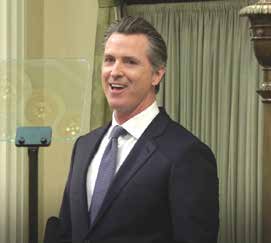by Dr. Marcy Adelman. This article originally appeared in the San Francisco Bay Times.

California Governor Gavin Newsom in his State of the State address on February 12 spoke to the issue of the aging of the state’s population. “We need to get ready.… For the first time in our history, older Californians will outnumber young children.” In fact, California’s population of older adults is projected to increase by four million people by 2030. The state’s newly elected governor announced his commitment to establish a Master Plan for Aging to meet the needs of California’s exploding population of older adults and people with disabilities.
In his speech, the Governor identified some of the pressing issues that will require attention: the need to coordinate the state’s “patchwork” of public services; the need for more affordable housing; a strategy to create a larger, better trained, culturally competent and appropriately compensated work force; and the need to make affordable in-home care more available to more people. The Governor’s commitment to older adults and people with disabilities is a welcome change from the previous administration that had made broad cuts in senior support services.
 Newsom’s Master Plan for Aging will hopefully restore and expand senior services and services for adults with disabilities. The Plan will have to take into account that California is the state with the highest percentage of older adults and people with disabilities living in poverty (21%). This percentage does not include those seniors across the state who are just one incident away—a rent increase or an unexpected medical bill—from slipping into poverty.
Newsom’s Master Plan for Aging will hopefully restore and expand senior services and services for adults with disabilities. The Plan will have to take into account that California is the state with the highest percentage of older adults and people with disabilities living in poverty (21%). This percentage does not include those seniors across the state who are just one incident away—a rent increase or an unexpected medical bill—from slipping into poverty.
The Justice in Aging 2018 report, Older Women and Poverty, points out: “Ever since the federal government began calculating the poverty rate in the 1960s, women have consistently experienced higher levels of poverty compared to men, with women of color, LGBTQ women and single women struggling most acutely.”
The majority of Californians living in poverty or on the brink of poverty are women. According to the policy brief, Aging Women and Poverty in California, one in 5 single older women live below the federal poverty level, and another 30 plus percent are unable to meet their basic living expenses despite higher incomes. Older women of color are at even greater risk of poverty. The Master Plan will need to identify policy initiatives to improve the lives of older women and may find the policy recommendations from Aging Women and Poverty in California a useful resource.
The state will also need to develop a comprehensive, strategic and culturally competent plan that addresses the aging issues faced by the most diverse state population of older adults in the country. In less than 10 years, Latinos will comprise 26% of California’s senior population, and Asian elders are expected to increase to 16 percent. The California LGB older adult population, currently estimated to be 431,800 people over the age of 50, is projected to double by 2030 (there is no statewide data on transgender older adults).
The Master Plan for Aging can only be successful by having direct input from all of the diverse communities served, including older adult people of color, people with disabilities, older adult women and older adult LGBTQI people.
Last October, the San Francisco LGBTQ senior serving agency Openhouse and We Stand With Seniors, an advocacy campaign led by the Scan Foundation and San Diego’s West Health, co-hosted a panel discussion: Advocating for LGBTQ Seniors in the Master Plan for Aging in California.
Panelists and community participants expressed concerns about accessing services, senior homelessness, challenges associated with long-term care facilities and difficulty securing safe, affordable housing. One panelist suggested that the Master Plan on Aging could be modeled after the successful report issued by San Francisco’s LGBT Aging Policy Task Force.
The Governor continued his State of the State address by speaking about the recent loss of his father with dementia and how, even with all of the advantages and privileges his father had, it was a challenge for him to meet his daily needs. In California, the number of people aged 65 and older with Alzheimer’s is expected to increase by almost 30%, from 650,000 people in 2018 to 840,000 people by 2025. With this in mind, he introduced the Alzheimer’s Prevention and Preparedness Task Force (APPTF) to be led by Maria Shriver, former first lady of California and longtime advocate for Alzheimer’s care and research.
The APPTF will focus on Alzheimer’s disease in women and communities of color. Women make up almost two thirds of older adults living with dementia. There has been a 241% increase in Alzheimer’s deaths in California since 2000, with most of those lost to this disease being women. Research has yet to conclusively identify the cause of higher risk in women or other at-risk populations, such as older adult people of color.
Older adult African Americans are two times more likely to develop Alzheimer’s disease and vascular dementia than older adult whites, but are less likely to receive a diagnosis. Older adult Latinos are 1.5 times more likely than older whites to develop Alzheimer’s or another dementia. It is unknown if LGBTQ older adult are at particular risk to developing Alzheimer’s, but we do know that LGBTQ older adults and their caregivers are underrepresented in dementia care services.
Governor Newsom’s commitment to develop a Master Plan for Aging and the Alzheimer’s Task Force are opportunities to address and impact economic and health disparities in older adult Californians. The Governor has set a thoughtful and meaningful course.
Dr. Marcy Adelman, Co-founder of the nonprofit Openhouse, oversees the Aging in Community column. She is a psychologist and LGBTQI longevity advocate and policy advisor. She serves on the California Commission on Aging, the Board of the Alzheimer’s Association of Northern California and Northern Nevada and the San Francisco Dignity Fund Oversight and Advisory Committee.
The opinions expressed in this article are those of the author and do not necessarily reflect those of the Diverse Elders Coalition.

